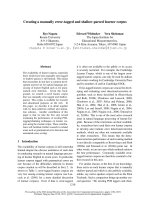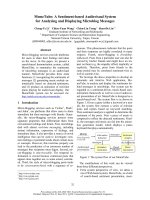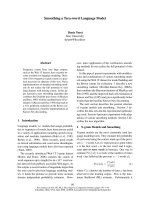Báo cáo khoa học: "Enhancing a large scale dictionary with a two-level system" potx
Bạn đang xem bản rút gọn của tài liệu. Xem và tải ngay bản đầy đủ của tài liệu tại đây (94.39 KB, 1 trang )
1
We present in this paper a morphological analyzer and
generator for French that contains a dictionary of
700,000 inflected words called DELAF 1, and a full two-
level system aimed at the analysis of new derivatives.
Hence, this tool recognizes and generates both correct
inflected forms of French simple words (DELAF look-
up procedure) and new derivatives and their inflected
forms (two-level analysis). Moreover, a clear distinction
is made between dictionary look-up processes and new
words analyses in order to clearly identify the analyses
that involve heuristic rules.
We tested this tool upon a French corpus of
1,300,000
words with significant results
(Clemenceau D. 1992). With regards to efficiency, since
this tool is compiled
into a
unique transducer,
it
provides a very fast look-up procedure (1,100 words per
second) at a low memory cost (around 1.3 Mb in
RAM).
Enhancing a large scale dictionary
with a two-level system
David Clemenceau &
Emmanuel Roche
LADL: Latxaatoire d'Automatique Documentaire et Linguistique
Universit6 Paris 7; 2, place Jussieu, 75251 Paris cedex 05, France
e-mail: roche@ max.ladl.jussieu.fr
Introduction [Trans((Pref * DELAS) c~ SaC) c~ Rules] u [•rans(Pref
• DELAFA) ~ Rules) o (Id(Pref• DELAF)] 2
This operation leads to the transducer of 1.3Mb with a
look-up procedure of 1,100 words per second, a sample
of which is given in the following figure:
2 Description of the analyzer
We fhst built the transducer representing all the entries
of DELAF along with their inflectionnal code. Each
entry defines a partial function, as in:
inculpons ~ inculper , V&P l p
which corresponds to the first person plural in the
present tense of the verb inculper (to charge someone).
The union of these 700,000 partial functions leads to
the transducer DELAF stored in 1Mb with a look-up
procedme of 1,100 words per second.
The 70 two-level rules that describe the way
characteas ate changed when prefixes or suffixes are
added
to words are themselves transducers (Karttunen et al.,
1992). The two following two-level rules generate the
two surface forms co[nculper and co-inculper when
adding the prefbt co- to the verb inculper:
i:i ¢*
c o -:0 *
i:i ~ c o -:- *
These 70 transducers have been merged into the
transducer Rules by performing an intersection.
The two transducers above have been merged with
four different DAGs, Pref, Suf, DELAS and DELAF A,
representing respectively a list of prefixes, a list of
suffixes, the list of canonical forms (inf'mitive form of a
verb for instance) and the whole list of the 700,000
inflected forms appearing in DELAF through the
following formula:
IDELAF stands for Electronic Dictionary of Inflected Forms
of the LADL (Courtois, 1990).
3 Results
We tested this transducer on a 1,300,000 words corpus
containing 58,000 different graphical forms. Our
transducer analyzed 75% of these graphical forms, which
is 3% more that the transducer of DELAF alone, at a
speed of 1,100 words per second. Hence, more than 97%
of the word occurrences of our corpus have been
analyzed in the following way:
algorithmisation ~ algorithme,N*iser,V*Ation,N* f*.s
References
[Clemenceau, 1992] David Clemenceau. Dictionary
completeness and corpus analysis. COMPLEX 92,
pp. 91-100. Linguistics Institute, Hungarian Academy
of Sciences, Budapest.
[Courtois, 1990] Blandine Courtois. Un systdme de
dictionnaires ~lectroniques pour les mots simples du
franfais in Langue Fran~aise n°87, Dictionnaires
~lectroniques du franfais. Larousse, Paris.
[Karttunen et al., 19921 Lauri Karttunen, Ronald M.
Kaplan, Annie Zaenen. Two-level morphology with
composition. COLING 92, pp. 141-148.
[Koskenniemi, 1984] Kimmo Koskenniemi. A general
computational model for word-form recognition and
production. COLING 84, pp. 178-181.
2Trans takes a DAG A and builds the transducer Trans(A)
whose language is L(A)xA*. Id takes a DAG A and builds
the identity function restricted to L(A). The operators * and
o respectively stand for concatenation and composition.
465









